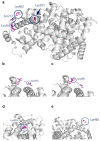The Potential Roles of Post-Translational Modifications of PPARγ in Treating Diabetes
- PMID: 36551260
- PMCID: PMC9775095
- DOI: 10.3390/biom12121832
The Potential Roles of Post-Translational Modifications of PPARγ in Treating Diabetes
Abstract
The number of patients with type 2 diabetes mellitus (T2DM), which is mainly characterized by insulin resistance and insulin secretion deficiency, has been soaring in recent years. Accompanied by many other metabolic syndromes, such as cardiovascular diseases, T2DM represents a big challenge to public health and economic development. Peroxisome proliferator-activated receptor γ (PPARγ), a ligand-activated nuclear receptor that is critical in regulating glucose and lipid metabolism, has been developed as a powerful drug target for T2DM, such as thiazolidinediones (TZDs). Despite thiazolidinediones (TZDs), a class of PPARγ agonists, having been proven to be potent insulin sensitizers, their use is restricted in the treatment of diabetes for their adverse effects. Post-translational modifications (PTMs) have shed light on the selective activation of PPARγ, which shows great potential to circumvent TZDs' side effects while maintaining insulin sensitization. In this review, we will focus on the potential effects of PTMs of PPARγ on treating T2DM in terms of phosphorylation, acetylation, ubiquitination, SUMOylation, O-GlcNAcylation, and S-nitrosylation. A better understanding of PTMs of PPARγ will help to design a new generation of safer compounds targeting PPARγ to treat type 2 diabetes.
Keywords: PPARγ; diabetes; post-translational modifications; thiazolidinediones.
Conflict of interest statement
The authors declare no conflict of interest.
Figures


Similar articles
-
Controlling a master switch of adipocyte development and insulin sensitivity: covalent modifications of PPARγ.Biochim Biophys Acta. 2012 Jul;1822(7):1090-5. doi: 10.1016/j.bbadis.2012.03.014. Epub 2012 Apr 4. Biochim Biophys Acta. 2012. PMID: 22504298 Free PMC article. Review.
-
New approach in the treatment of T2DM and metabolic syndrome (focus on a novel insulin sensitizer).Acta Med Indones. 2006 Jul-Sep;38(3):160-6. Acta Med Indones. 2006. PMID: 17119268 Review.
-
PPARγ signaling and metabolism: the good, the bad and the future.Nat Med. 2013 May;19(5):557-66. doi: 10.1038/nm.3159. Epub 2013 May 7. Nat Med. 2013. PMID: 23652116 Free PMC article. Review.
-
Peroxisome proliferator-activated receptor gamma agonists as insulin sensitizers: from the discovery to recent progress.Curr Top Med Chem. 2008;8(17):1483-507. doi: 10.2174/156802608786413474. Curr Top Med Chem. 2008. PMID: 19075761 Review.
-
Pleiotropic effects of PPARγ agonist on hemostatic activation in type 2 diabetes mellitus.Curr Vasc Pharmacol. 2013 May;11(3):338-51. doi: 10.2174/1570161111311030008. Curr Vasc Pharmacol. 2013. PMID: 23650948 Review.
Cited by
-
Harnessing peroxisome proliferator-activated receptor γ agonists to induce Heme Oxygenase-1: a promising approach for pulmonary inflammatory disorders.Cell Commun Signal. 2024 Feb 15;22(1):125. doi: 10.1186/s12964-024-01501-4. Cell Commun Signal. 2024. PMID: 38360670 Free PMC article. Review.
-
PPARγ in Atherosclerotic Endothelial Dysfunction: Regulatory Compounds and PTMs.Int J Mol Sci. 2023 Sep 24;24(19):14494. doi: 10.3390/ijms241914494. Int J Mol Sci. 2023. PMID: 37833942 Free PMC article. Review.
-
The Deficits of Insulin Signal in Alzheimer's Disease and the Mechanisms of Vanadium Compounds in Curing AD.Curr Issues Mol Biol. 2023 Jul 31;45(8):6365-6382. doi: 10.3390/cimb45080402. Curr Issues Mol Biol. 2023. PMID: 37623221 Free PMC article. Review.
-
Mechanisms of the NAD+ salvage pathway in enhancing skeletal muscle function.Front Cell Dev Biol. 2024 Sep 20;12:1464815. doi: 10.3389/fcell.2024.1464815. eCollection 2024. Front Cell Dev Biol. 2024. PMID: 39372950 Free PMC article. Review.
-
Hydrogen Sulfide: An Emerging Regulator of Oxidative Stress and Cellular Homeostasis-A Comprehensive One-Year Review.Antioxidants (Basel). 2023 Sep 7;12(9):1737. doi: 10.3390/antiox12091737. Antioxidants (Basel). 2023. PMID: 37760041 Free PMC article. Review.
References
-
- Diabetes around the World in 2021. International Diabetes Federation; Brussels, Belgium: 2022. IDF Diabetes Atlas 10th Edition and other resources.
Publication types
MeSH terms
Substances
Grants and funding
LinkOut - more resources
Full Text Sources
Medical
Miscellaneous

